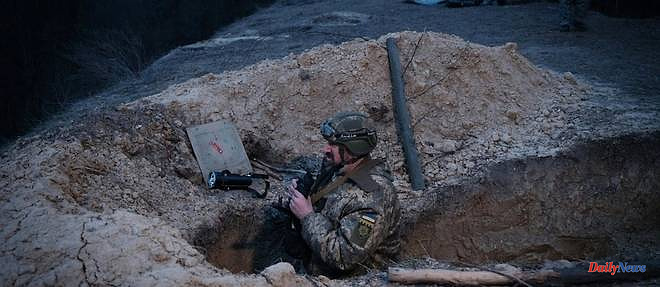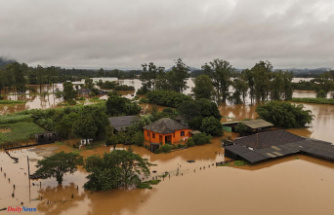They raised their fists shouting victory. Since October, with their 1920s machine gun, Colonel "Smak" and his unit of Ukrainian volunteers have shot down three explosive drones launched by the Russians on Kiev.
"The first drone was in October. It was flying by day, so it was clearly visible. We opened fire when it entered our sector," "Smak" told AFP. war --, retired colonel of the Ukrainian security services.
"The other two were flying on New Year's Eve. Our colleagues shone spotlights (on the drones) and with thermal night binoculars, we spotted them and shot them down. I myself fired a machine gun, "continues the 49-year-old man with a gray beard and the build of a rugby player.
He commands a group of 80 civilian volunteers -- retired or active -- who take turns in shifts of seven, day and night. Each performs twelve hours of call duty, on average twice a week.
In the small room on the ground floor of a building under construction where they have their base, in a suburb of kyiv, it is the succession. It is 8:00 p.m., the rising team of volunteers will spend the night there.
If the air-raid sirens sound, they race in vehicles to a nearby hill, where they position themselves in individual firing positions.
A dozen of these units, attached to the territorial defense, thus cover the sky of the capital.
Their target: Iranian-made "Shahed" explosive drones, launched by the Russians in massive attacks on energy sites in Ukraine.
In addition to Kalashnikovs, the group has two DP-27, a submachine gun adopted by the Soviet army in 1927 and known to fans of the hit video game "Call of Duty", recognizable by its large circular magazine fixed flat on the barrel. The bullets are tracers, to follow their trajectory and correct the shot.
"We have a lot of units (across the country) that monitor and give the position of drones", launched from the Black Sea (South) or the Russian border (East), explains Mykola, 50, deputy of the unit , evoking an "electronic but also visual" identification.
But since October, Ukraine has strengthened its air defense capabilities. Westerners have already supplied, or will deliver, modern systems to kyiv (NASAMS, IRIS-T, Aspide 2000, Hawk, Patriot, etc.). And Russian attacks have become less frequent or massive.
"Right now we don't have a lot of alerts, it's a more or less calm period," notes Mykola.
In the custody room, you have to kill time.
Mykola monitors on his tablet the map of the country where the flight of a drone can appear in real time.
On his desk, a walkie-talkie connected to the command of the units crackles every hour sharp, for the radio control of the teams.
Sitting on a faded sofa, "Valdemar", 19, a computer science student, is busy cleaning a DP-27 he has just dismantled.
At his side, his father, nicknamed "Customs", 56, does the same with a Kalashnikov rifle.
10:20 p.m .: "Two Shahed destroyed in Dnipro", in the center-east, launches Mykola, looking at his tablet.
11:00 p.m.: start of the curfew, kyiv falls asleep in silence.
The night is advancing, without warning sirens or approaching drones.
"Smak", passionate about military figurines, whose collection displays 5,000 pieces, ends a game of the strategy game "Blood Bowl", disputed online against his 13-year-old son, temporarily living in the Netherlands.
Midnight: Two volunteers go to sleep in a room furnished with three basic beds and an old wood stove.
1:30 a.m.: "Smak" and "Customs" begin a discussion about the best rate of fire to shoot down a drone. “It makes no sense to shoot piecemeal, you have to shoot in bursts,” asserts the colonel.
After 2 a.m., eyelids close, heads drop, warmly dressed volunteers slump on chairs or sofas.
Only Mykola is still watching.
05:00: end of the curfew, the group wakes up, the coffee is hot. Outside the cold is sharp.
6:00 a.m.: the warning siren has remained silent, but to stretch their legs and not lose their grip, part of the team climbs the hill with arms. Everyone takes their place, without firing.
Planted in a deep hole dug in the ground, cap on the ears, the young "Valdemar" points the long barrel of the DP-27 towards the south.
“The worst is the fog,” he says. "When you hear the drone fly but you can't see it, and then you hear it hit a target."
"We are the last line of defense", assures Mykola, binoculars around his neck.
But "if we had a kind of iron dome (air defense system), like in Israel, I would be happy," he adds.
03/03/2023 19:33:38 - Kiev (Ukraine) (AFP) © 2023 AFP












